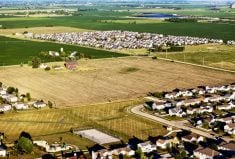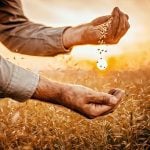On a recent trip to Queen’s Park, the group I was with was afforded a brief tour of the historic building. Walking through portrait-laden hallways filled with the faces of past legislators who shaped Ontario’s economic and social landscape, it’s easy to miss some of the smaller details hidden amongst the intentional grandeur.
While taking a moment to explore the west wing of the building, I noticed a small, unassuming painting by renowned Canadian artist George Agnew Reid, simply titled Mortgaging the Homestead.
The oil on canvas was a preliminary sketch for a large-scale narrative painting of the same title, which is currently in the collection of the National Gallery of Canada. Reid was born on a Wingham, Ontario-area farm and used his formative years as inspiration for many of his paintings. His own family was forced to mortgage their farm, an event in the late 1800s that brought with it a sense of failure and shame.
Read Also

Melancthon faces a new quarry fight over water, environment and farmland risks
A proposed Strada blast quarry in Melancthon, Ont., sparks regional debate over water protection, farmland sustainability, and Ontario’s aggregate policy.
In a time when many farmers are facing financial hardship with limited resources from the federal and provincial governments, I thought about how this painting stands as a testament to the resilience of farmers.
Canadian farm debt has been on a notable increase, reaching $146 billion by the end of 2023, a 4.1 per cent increase from the previous year and a 103 per cent increase since 2012, according to Syngenta Canada. The bulk of the 2023 farm debt, the report said, was owed to chartered banks and federal agencies at about $51 billion and $43 billion, respectively, with credit unions owed around $22.3 billion, demonstrating that farmers continue to be well entrenched in debt to banks and other creditors at an increasing rate.
In 2020, the National Farmers Union released new data showing that the combination of high costs, low net income, and rising debt had forced nearly a third of Canadian farm families off the land in just one generation, noting that 28 years earlier there were 280,000 farms in Canada.
By 2020, this number had dropped to 193,000. This number is expected to drop even further to 100,000 by 2050 as young farmers continue to face barriers to entry into the agriculture sector.
Like many other Canadians, farmers are also heavily at risk of financial loss due to injury or unplanned income interruption, notably captured in Reid’s sequel painting ‘Foreclosure of the Mortgage’ which shows a family gathered around a bedridden father as they listen to a bailiff read a notice of repossession.
So, what are the federal and provincial governments doing to help lessen this burden? With the cost of farming skyrocketing, tariffs driving up the price of goods and equipment, and land prices at all-time highs, the limited programs available are doing little to turn the tide in what could be a wave of farmers choosing to or being forced to leave agriculture.
The same halls that keep this painting should also be where conversations are happening to ensure that the sustainability of farming continues to grow in Ontario and across the country.
As these “conversations” occur, it is important that farmers use their own advocacy powers to let their voices be heard.
Additionally, a new path must be charted for young farmers, with greater access to funds and improved programs designed to make it easier to build the homesteads of the future.
Divisive politics aside, farmers must speak to what is in the best interest of their survival and challenge party leaders of all stripes to vote based on the survival of farming in Canada and paint a new picture of the agricultural landscape.















